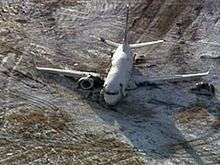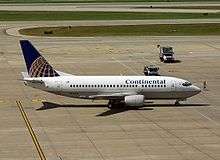Continental Airlines Flight 1404
 | |
| Runway excursion summary | |
|---|---|
| Date | December 20, 2008 |
| Summary | Runway excursion due to wind. |
| Site |
Denver, Colorado 39°52′30″N 104°41′13.24″W / 39.87500°N 104.6870111°WCoordinates: 39°52′30″N 104°41′13.24″W / 39.87500°N 104.6870111°W |
| Passengers | 110[1] |
| Crew | 5[1] |
| Fatalities | 0 |
| Injuries (non-fatal) | 47 |
| Survivors | 115 (all) |
| Aircraft type | Boeing 737-524[2] |
| Operator | Continental Airlines |
| Registration | N18611[2] |
| Flight origin | Denver International Airport |
| Destination | George Bush Intercontinental Airport |
Continental Airlines Flight 1404 was a Continental Airlines flight from Denver International Airport in Denver, Colorado, United States to George Bush Intercontinental Airport in Houston, Texas.[1] On the evening of December 20, 2008, the flight crashed while taking off from Denver resulting in 2 critical injuries, 36 non-critical injuries and a hull loss of the Boeing 737-524 aircraft.[1][2]
Incident

On Saturday, December 20, 2008 at approximately 18:18 (06:18PM) local time, after being cleared for takeoff on runway 34R at Denver International Airport, the Boeing 737-524 aircraft veered off the side of the runway before taxiway WC (less than 4,000 feet (1,200 m) from the threshold), skidded across the taxiway and a service road and crashed in a 40-foot-deep (12 m) ravine several hundred yards from the runway.[2][3] The plane caught fire at some point during the sequence.[3][4]
Despite early confusion as to the whereabouts of Flight 1404, firefighters were on scene relatively quickly, as the aircraft came to rest near one of the airport's four fire houses.[3] When they arrived, most of the right side of the plane was on fire while passengers were climbing out of the left side, being assisted by flight attendants[5] and one off-duty Continental Airlines pilot in the cabin, the latter making several trips in and out of the wreckage to ensure everyone was safely out of the aircraft.[6][7]
The aircraft sustained severe damage. The fuselage was cracked just behind the wings, the number 1 engine and main landing gear were sheared off, and the nose gear collapsed.[3] The fire caused overhead luggage compartments to melt onto seats.[8]
The crash is noted as the most serious incident in DIA's history.[9] The aircraft was subsequently written off.[2]
Injuries
Of the 110 passengers and 5 crew on board,[1] 47 sustained injuries including broken bones, though everyone on board survived.[10][11][12] Two injuries were critical, though both passengers' conditions were upgraded that evening.[13] By the following morning, fewer than seven people remained hospitalized.[13]
The captain was among the critically injured.[14] He was hospitalized with serious back injuries and bone fractures.[15]
Investigation
The aircraft's black boxes were recovered from the wreckage in usable condition.[16] The cockpit voice recorder did not reveal any apparent problem until 41 seconds after the aircraft's brakes were released, just before takeoff.[17][18] At that point a bumping or rattling sound can be heard, and the crew aborted the takeoff four seconds later. Both recorders stopped working six seconds after that (before the plane came to a stop).[17][18] At one point during the sequence, the plane's speed reached 119 knots (220 km/h).[17][18]
When interviewed, the first officer told investigators that he was unaware of any problem until the plane was traveling between 87 and 90 knots (161 and 167 km/h), when it moved away from the runway's centerline and made a "sudden left turn".[18] He indicated that the captain, who was too badly injured to interview with officials when the investigation began, was flying at the time.[17][18] Both the captain and first officer had clean safety records when the crash occurred and were experienced pilots.[4][18]
Wheel marks left on the ground as well as initial reports from passengers and firefighters indicate that the plane was airborne, briefly.[3][19] It is unclear at which point during the sequence the fire started.[16][19] There was no snow or ice on the runway, however there were 31-knot (57 km/h) crosswinds at the time.[20][21]
The flight crew that flew the aircraft to Denver prior to the incident flight was also on board, though not on duty, and reported having no difficulties with the plane during their previous flight.[17] It suffered an engine failure and subsequent emergency landing in 1995, following which both engines were replaced, but was otherwise undamaged in that incident.[4]
Initial speculation suggested that the plane could have suffered a landing gear malfunction that might have resulted in a wheel lockup during the takeoff roll, leading to the runway excursion.[5][11][14] NTSB officials said that when the takeoff began, the aircraft's engines appeared to be functioning properly, its tires were inflated, and the brakes did not appear as if they had failed or otherwise malfunctioned, concluding that the landing gear did not cause any problems.[17][18]
On July 17, 2009 it was announced that focus had shifted to a possible large gust of wind or a patch of ice. The pilot of the aircraft stated that: "My speculation is that we either got a big, nasty gust of wind or that, with the controls we had in, we hit some ice." The winds were reported at about 28 to 31 mph (45 to 50 km/h) from the northwest with gusts up to nearly 37 mph (60 km/h) just before the airliner began its takeoff roll northward down a north-south runway. The 737 has a crosswind limitation for takeoff of 38 mph (61 km/h) on a dry runway.[22]
According to an article published on July 18, 2009, in the Denver Post, Flight 1404 had been equipped with winglets, curved, upswept structures added to the tips of wings, in November 2008. The article states that "Continental's B-737 flight manual 'limitations section' showed a crosswind limit of 33 knots for a dry runway...But NTSB added that the manufacturer and installer of winglets that were on the airplane had published 'a maximum demonstrated crosswind component of 22 knots for winglet-equipped B-737-500s.'"[23]
On July 13, 2010 the NTSB published that the probable cause of this accident was the captain's cessation of right rudder input, which was needed to maintain directional control of the airplane, about 4 seconds before the excursion, when the airplane encountered a strong and gusty crosswind that exceeded the captain's training and experience.[24]
See also
- Air France Flight 358
- Aviation safety
- List of accidents and incidents involving commercial aircraft
- USAir Flight 5050
References
- 1 2 3 4 5 "Continental Airlines Responds to Flight 1404 Accident" Continental Airlines. December 21, 2008. Retrieved on December 20, 2008. Archived February 18, 2012, at the Wayback Machine.
- 1 2 3 4 5 Continental Flight CO1404. Aviation Safety Network. Retrieved on December 21, 2008.
- 1 2 3 4 5 "NTSB begins investigation into why plane slid off runway." 9NEWS. December 21, 2008. Retrieved on December 21, 2008.
- 1 2 3 "Cause of Denver plane accident unclear, transportation officials say". Los Angeles Times. December 22, 2008. Retrieved on December 22, 2008.
- 1 2 Schmollinger, Christian and Cynthia Cotts. "Continental Flight Skids Off Runway, Injuring Some (Update3)." Bloomberg. December 21, 2008. Retrieved on December 21, 2008.
- ↑ "Archived copy". Archived from the original on 2010-12-19. Retrieved 2010-12-14.
- ↑ http://www.chron.com/disp/story.mpl/metropolitan/7334578.html
- ↑ Correll, DeeDee. "Continental flight veers off Denver runway, injures dozens." Los Angeles Times. December 21, 2008. Retrieved on December 21, 2008. Archived January 30, 2009, at the Wayback Machine.
- ↑ "Plane wreckage could be moved next week". 9NEWS. December 26, 2008. Retrieved on December 26, 2008.
- ↑ NTSB final report, section 1.2 "Injuries to persons", page 6
- 1 2 "Brakes eyed in Denver plane crash." MYSA. December 21, 2008. Retrieved on December 22, 2008.
- ↑ "Firefighter recalls a miracle on a Denver runway." Associated Press. December 21, 2008. Retrieved on December 21, 2008.
- 1 2 Wyatt, Kirsten. "Firefighter says it's a 'miracle' no one died in Denver burning jet." Associated Press. Sunday December 21, 2008. Archived February 24, 2012, at the Wayback Machine.
- 1 2 "Source: Landing gear, wheels, brakes possible cause of crash". CNN. December 22, 2008. Retrieved 2008-12-22.
- ↑ Pasztor, Andy (December 23, 2008). "Investigators Confirm Continental Jet Crew Tried to Abort Takeoff". Wall Street Journal. Retrieved 2008-12-23.
- 1 2 "Plane's 'black boxes' recovered". Denver Post. December 21, 2008. Retrieved on December 22, 2008.
- 1 2 3 4 5 6 "NTSB: Wheels, brakes didn't cause Continental accident". CNN.com. 22 December 2008. Retrieved 22 December 2008.
- 1 2 3 4 5 6 7 "DIA crash details emerge". The Denver Post. December 23, 2008. Retrieved on December 23, 2008.
- 1 2 "Aerial video indicates breakup sequence of crashed plane". 9NEWS. December 22, 2008. Retrieved December 22, 2008.
- ↑ "Continental Airlines Statement Regarding Flight 1404." Continental Airlines. December 20, 2008. Retrieved on December 21, 2008. Archived February 18, 2012, at the Wayback Machine.
- ↑ "Continental flight slides off runway; dozens injured". 9NEWS. 21 December 2008. Retrieved 21 December 2008.
- ↑ Lowy, Joan. "Pilot recalls 'massive gust of wind' before crash." USA Today. July 17, 2009. Retrieved on December 29, 2009.
- ↑ Jeffrey Leib (18 July 2009). "Winds surprised crew on DIA flight". The Denver Post. Retrieved 15 September 2010.
- ↑ National Transportation Safety Board (July 13, 2010). "Runway Side Excursion During Attempted Takeoff in Strong and Gusty Crosswind Conditions" (PDF). Retrieved March 27, 2015.
External links
- NTSB Safety Recommendation
- Current investigation reports from NTSB
- NTSB update on factual information about the accident
- Photo slideshow of the aircraft after the crash (Images)
- Continental 737 runs off runway at Denver International Airport (Wikinews)